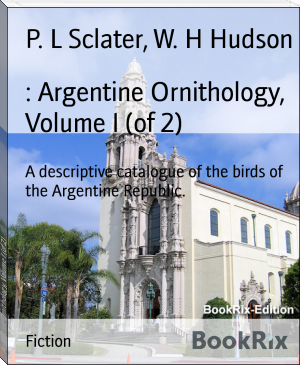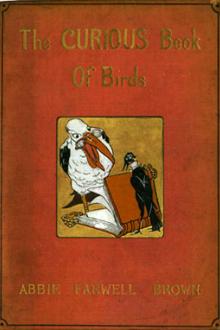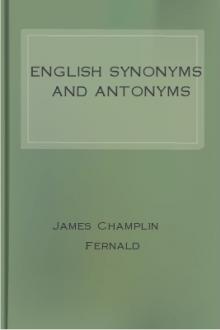: Argentine Ornithology, Volume I (of 2), P. L Sclater, W. H Hudson [best authors to read txt] 📗

- Author: P. L Sclater, W. H Hudson
Book online «: Argentine Ornithology, Volume I (of 2), P. L Sclater, W. H Hudson [best authors to read txt] 📗». Author P. L Sclater, W. H Hudson
another. It always alights on the trunk close to the ground, clinging to
the bark in a vertical position, supported by the tail, and with head
thrown far back in order to give free play to the extremely long beak.
Having thus alighted, it progresses upwards by short hops, exploring the
crevices in the wood for small insects, until it reaches the branches,
when it flies off to the next tree.
Fam. XVIII. FORMICARIIDÆ, or ANT-BIRDS.
The Formicariidæ, or Ant-birds, are another very important constituent
of the Neotropical Avifauna, but are less generally diffused than the
Dendrocolaptidæ, the greater number of the forms being restricted to the
hot forests of South and Central America. In the Argentine Republic we
meet with only four species of the widely-spread genus _Thamnophilus_,
and of them only one appears to extend as far south as Buenos Ayres.
THAMNOPHILUS LEACHI (Such).
(LEACH'S BUSH-BIRD.)
+Thamnophilus leachi+, _Scl. et Salv. Nomencl._ p. 69; _White, P. Z.
S._ 1882, p. 614 (Misiones).
_Description._--Black, thickly and conspicuously spotted above with
white or pale yellowish; on the wings the spots occur on the outer
webs of the feathers; upper tail-coverts faintly edged with grey;
tail black, unspotted; feathers on the lower breast and belly
slightly edged with grey; bill and feet black: whole length 10·5
inches, wing 3·4, tail 5·0. _Female_: spots larger and yellow, on
the crown lengthening to stripes and tinged with rufous; inner webs
of the wing-feathers also spotted on their margins; whole under
surface thickly spotted with pale yellow.
_Hab._ Brazil and N. Argentina.
White met with a single individual of this fine Bush-bird at Concepcion,
Misiones. It was observed on the ground feeding on a swarm of black
ants.
THAMNOPHILUS MAJOR, Vieill.
(LARGER BUSH-BIRD.)
+Thamnophilus major+, _Scl. et Salv. Nomencl._ p. 69; _White, P. Z.
S._ 1882, p. 614 (Salta); _Salvin, Ibis_. 1880, p. 359 (Salta).
+Thamnophilus stagurus+, _Burm. La-Plata Reise_, ii. p. 471
(Paraná, Tucuman).
_Description._--Above black, upper wing-coverts crossed by a row of
white spots; the outer rectrix on each side tipped and barred with
white, the other rectrices, excepting the middle pair, spotted with
white on their inner webs; beneath pure white; bill black, feet
grey: whole length 8·0 inches, wing 3·6, tail 2·8. _Female_ above
rufous, beneath white, lower flanks and under tail-coverts tinged
with ochraceous; tail wholly rufous.
_Hab._ Paraguay and N. Argentina.
White found this species common in the gardens round the town of Oran.
He noted the iris as "crimson."
Azara's account of this species is prefaced by the following remarks on
the birds of this genus known to him in Paraguay:--"These birds inhabit
only the dense and tangled thickets, and never show themselves outside
of their hiding-places, except for a few moments in the early morning
and in the evening; but at no time do they perch high on the trees, but
keep always within a few feet of the earth. They live in pairs; feed
solely on insects caught in the bushes which they frequent, or on the
ground, on which, however, the bird alights only to pick up its prey,
and then returns to the twig to devour it. They are stationary, and fly
only from one thicket to another. Many of the species have a similar
voice or song, which is singular, powerful, and heard only in the
love-season. The call is a trill of a single note rapidly reiterated,
and loud enough to be heard half a mile away; the cry being accompanied
by vibratory motions of the wings."
THAMNOPHILUS CÆRULESCENS, Vieill.
(SLATY-BLUE BUSH-BIRD.)
+Thamnophilus cærulescens+, _Burm. La-Plata Reise_, ii. p. 472
(Paraná, Mendoza, Tucuman); _Scl. et Salv. Nomencl._ p. 70;
_White, P. Z. S._ 1882, p. 614 (Corrientes, Misiones); _Barrows,
Auk_, 1884, p. 21 (Entrerios); _Salvin, Ibis_, 1880, p. 361
(Salta).
_Description._--Above grey, black on the crown, and a patch of white
and black feathers on the middle of the back; wings black, the
coverts thickly spotted and the inner webs of the remiges edged with
white; tail black, all the feathers, except the middle pair, tipped
with white, the outer rectrix on each side has also a long white
spot in the middle part of the outer web; beneath cinereous, white
on the belly; bill and feet black: whole length 5·6 inches, wing
2·7, tail 2·3. _Female_: above earthy olive-green, yellowish on
the crown; wing-coverts and tail as in the male; wing-feathers
olive-brown; beneath yellowish olive-grey, brightening into
ochraceous on the belly and flanks.
_Hab._ Paraguay and Argentina.
Mr. Barrows says concerning this species that it is "frequently seen,
especially during the winter" (on the Lower Uruguay). A nest, taken
November 24th, "was almost precisely like that of our Red-eyed Vireo
(_V. olivaceus_), being pensile in the fork of a horizontal spray, only
four feet from the ground. It contained three fresh eggs, white, with
spots and dashes of light brown."
White says that these birds frequent the banks of streams, and have a
deep bass call-note, rather mournful and slow.
THAMNOPHILUS RUFICAPILLUS, Vieill.
(RED-CAPPED BUSH-BIRD.)
+Thamnophilus argentinus+, _Burm. La-Plata Reise_, ii. p. 472
(Paraná, Tucuman); _Scl. et Salv. Nomencl._ p. 70; _Durnford,
Ibis_, 1877, p. 183 (Buenos Ayres); _Barrows, Auk_, 1884, p. 21
(Entrerios). +Thamnophilus ruficapillus+, _Pelz. Orn. Bras._ p.
79; _Berl. et Jher. Zeitschr. ges. O._ 1885, p. 49.
_Description._--Above olivaceous brown, tinged with rufous, brighter
on the crown; lores yellowish white, superciliaries and sides of
head whitish grey; wing-feathers dark olive-brown, the inner webs
edged with ochraceous; tail black, all the rectrices, except the
middle pair, slightly tipped and broadly spotted on the inner webs
with white; beneath greyish white, the feathers from the lower
throat to the belly transversely barred with black; bill and feet
black: whole length 6·2 inches, wing 2·7, tail 2·6. _Female_: above
the same as the male, except the tail, which is rufous brown;
beneath whitish, tinged with ochraceous, and with scarcely
perceptible greyish mottlings.
_Hab._ Paraguay and Argentina.
This species is very common in the eastern provinces of Argentina, and
extends south to Buenos Ayres. It is a shy, solitary bird, found in
woods and thickets along the shores of La Plata; and utters occasionally
a singular low rasping note, its only language. The nest is a slight
shallow structure placed in a low tree; the eggs are white, thinly
spotted with reddish brown. Probably this species is to some extent
migratory, as I have only observed it in the summer season.
Fam. XIX. PTEROPTOCHIDÆ, or TAPACOLAS.
The Pteroptochidæ form a small but very peculiar family of
Tracheophonine Passeres, mostly restricted to Chili and the
south-western extremity of the South-American Continent, but also
represented in the Andes of Ecuador and Colombia and in the high
plateau of Central Brazil. They are ground-birds, remarkable for their
large and robust feet with long claws, their strangely formed bills, and
the elevated position in which the tail is carried in the living bird.
In the Argentine Republic four species of Pteroptochidæ are known to
occur, only one of which, however, is a well-known bird. Two of the
remaining three are recent discoveries, and the fourth a Chilian
species, which extends over the Andes into the western borders of
Argentina.
SCYTALOPUS SUPERCILIARIS, Cab.
(WHITE-EYEBROWED SCYTALOPUS.)
+Scytalopus superciliaris+, _Cab. Journ. f. Orn._ 1883, p. 105, t.
fig. 3 (Tucuman).
_Description._--Nearest to _S. indigoticus_ of Brazil, but without
the white colour on the breast and belly, only the throat being
clear white; superciliaries striped white; front and sides of the
head and neck, breast and belly grey; rest of the upper surface,
together with the flanks and crissum, light brown, with fine
blackish cross-markings; bill blackish, feet light-coloured.
_Hab._ Sierra of Tucuman.
This species is one of Schulz's recent discoveries in the Sierra of
Tucuman, where he found it west of Sauciyaca, frequenting the deep
ravines.
RHINOCRYPTA LANCEOLATA, Geoffr. et d'Orb.
(GALLITO.)
+Rhinocrypta lanceolata+, _Burm. La-Plata Reise_, ii, p. 471
(Mendoza, San Juan, Catamarca); _Scl. et Salv. Nomencl._ p. 70;
_Hudson, P. Z. S._ 1872, p. 543 (Rio Negro); _White, P. Z. S._
1882, p. 614 (Catamarca).
_Description._--Above, head and upper neck reddish brown with a
fine white shaft-stripe on each feather, the stripes being most
conspicuous on the crest-feathers; lower neck, back, rump, and wings
greyish olive; tail blackish; beneath, throat and upper part of
breast, grey, becoming pure white on the middle of the belly; sides
of belly and flanks bright chestnut; lower part of belly and flanks
and under tail-coverts like the back; bill horn-colour, feet black:
whole length 8·2 inches, wing 3·3, tail 3·0. _Female_ similar.
_Hab._ Western and Southern Argentina and Patagonia.
The vernacular name _Gallito_, or "Little Cock," by which this species
is familiarly known in Patagonia, cannot fail to strike every one who
sees the bird as very appropriate, for it struts and runs on the ground
with tail erect, looking wonderfully like a small domestic fowl. In the
neighbourhood of Carmen, on the Rio Negro, it is very abundant, and
when I went there its loud deep chirrup, heard from every side in the
thicket, quickly arrested my attention, just as the perpetual chirping
of the Sparrows did when I first landed in England. In the interior of
the country it is not nearly so abundant, so that man's presence has
probably in some way affected it favourably. Its habits amuse and baffle
a person anxious to make its acquaintance; for it scarcely possesses the
faculty of flight, and cannot be driven up, but it is so easily alarmed,
so swift of foot, and so fond of concealment, that it is most difficult
to catch a sight of it. At the same time it is extremely inquisitive,
and no sooner does it spy an intruder in the bush than the warning note
is sounded, whereupon every bird within hearing hops up into a thick
thorn-bush, where it utters every three or four seconds a loud hollow
chirrup, and at intervals a violent scolding cry, several times
repeated. When approached they all scuttle away, masked by the bushes,
with amazing swiftness, to take refuge at a distance, where the loud
protest is again resumed; but when the pursuer gives up the pursuit
in disgust and turns away, they immediately follow him, so that he is
perpetually encircled with the same ring of angry sound, moving with
him, coming no nearer and never allowing its cause to be seen.
On three or four occasions I have seen one rise from the ground and fly
several yards with a feeble fluttering flight; but when closely pursued
in an open place they seem incapable of rising. They generally fly down
from the top of a bush, but always ascend it by hopping from twig to
twig.
The nest is made in the centre of a thorny bush two or three feet from
the ground; and is round and domed, with a small aperture at the side,
and built entirely of fine dry grass. The eggs are four in number and of
a pure white.
The Little Cock is nine inches long, has long stout legs, and short,
curved beak. The colour of the head and neck is deep reddish brown,
lined with white, the feathers of the crown forming a crest. The upper
surface and wings olive-brown; tail dark; throat and breast grey; middle
of the belly white, with a broad ruddy rufous patch on each side
reaching to the belly.
RHINOCRYPTA FUSCA, Scl. et Salv.
(BROWN GALLITO.)
+Rhinocrypta fusca+, _Scl. et Salv. Nomencl._ pp. 76, 161.
_Description._--Above uniform pale cinnamomeous brown; superciliaries
whitish; tail blackish, except the middle pair of rectrices, which
are the same as the back; beneath white, faintly tinged with
cinnamomeous; bill horn-colour, feet black: whole length 6·5 inches,
wing 2·5, tail 2·4.
_Hab._ Mendoza.
The original examples of this species were obtained by the German
collector, Weisshaupt, near Mendoza. It appears to have been mistaken
for the young of the preceding species, but is decidedly different.
PTEROPTOCHUS ALBICOLLIS, Kittl.
(WHITE-NECKED TAPACOLA.)
+Pteroptochus albicollis+, _Burm. La-Plata Reise_, ii. p. 471
(Mendoza); _Scl. et Salv. Nomencl._ p. 76.
_Description._--Above chestnut-brown, obscure or slightly olivaceous
on the neck and upper part of back; inner webs of wing-feathers
blackish; lores, superciliaries, and under surface white, the breast
sparsely, and the belly and flanks thickly marked with transverse
spots of blackish brown; lower flanks and under tail-coverts
chestnut-brown, obscurely spotted with black; bill and feet black:
whole length 8·5 inches, wing 3·1, tail 2·9. _Female_ similar.
_Hab._ Chili and Western Argentina.
Dr. Burmeister tells us that he met with this Chilian species in the
water-courses near Mendoza, where it was seen running about on the
stones like a Dipper.
Darwin has given us some interesting notes on this bird:--"This species
is called by the Chilenos 'Tapacola,' or 'cover





Comments (0)